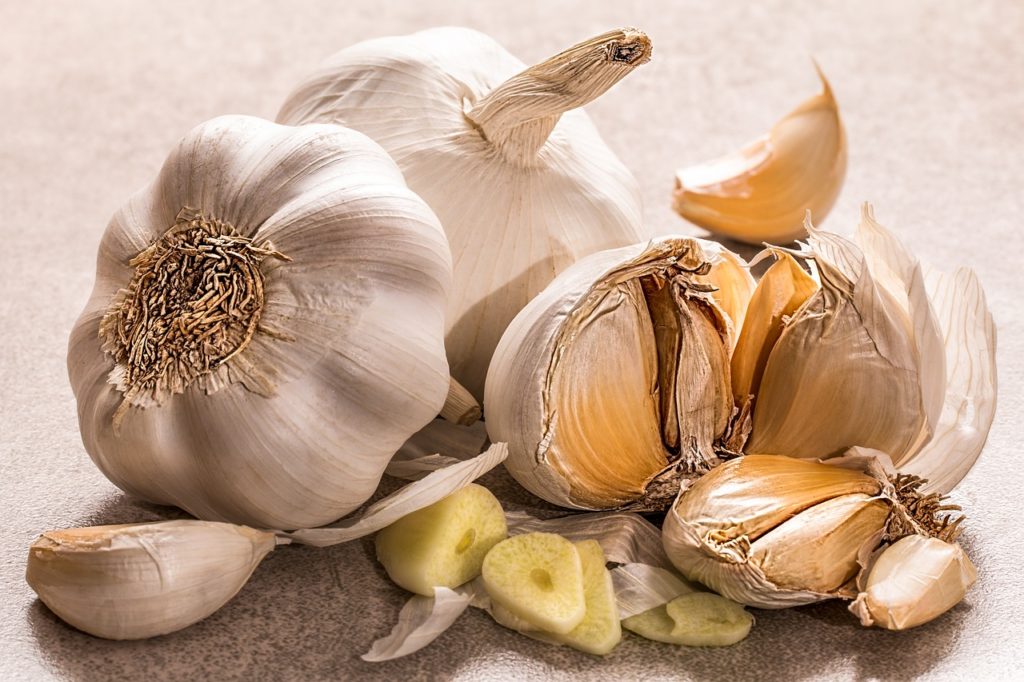Let us get to know garlic
Garlic, Allium sativum, is a perennial plant known to originate in Southeastern Asia. It was later introduced to the Mediterranean and then cultivated worldwide. Medicinal parts are the whole fresh bulb, dried bulb and the oil of garlic. In 1858, Lois Pasteur found that garlic kills gram negative bacteria, in comparison to penicillin. Thus also called “The Russian penicillin” in World War ll.
An antioxidant, antibacterial, antiviral, antifungal
Garlic enhances natural killer cells, with broad spectrum activity against bacteria, fungi and viruses. It increases gluthathione levels and cellular functions which helps in premature aging and prevents generation of free radicals. It also reduces the line of nitric oxide and lipid peroxidation, increasing the levels of antioxidants vitamin A, C and selenium, and lowers cholesterol and blood pressure levels. Garlic stimulates the proliferation of lymphocytes and macrophages and protects against the suppression of immunity by UV radiation.
Within 10 minutes of cutting, bruising, biting, or crushing the bulb, an enzyme alliinase is released, producing allicin, which is responsible for its antifungal, antiplatelet and antibacterial properties. Research shows effectiveness against vancomycin resistant enterococci in in vitro studies. Compounds ajoene demonstrated antimycotic effect as well as thiosulfinate is found responsible for the antimycobacterial activity of garlic.
On Cancer and Chelation
Studies show that it interferes with carcinogens that require metabolic activation, hinders carcinogenesis thus inhibiting cancer cell growth and promoting chemical carcinogen detoxification. Sulfur and hydrogen are the sulfhydryl compounds that bind toxic heavy metals for chelation to be excreted out of the body.
On Cardiovascular System
Methyl-allyl-trisulfide is the component in garlic that dilates blood vessels and helps lower blood pressure. It helps reduce the risk for blood clots by inhibiting platelet aggregation, which thins the blood, therefore preventing heart attacks. A compound ajoene showed antithrombotic effect, inhibiting lipoxygenases and increasing fibrinolysis.
What causes garlic breath?
Referred to as “the stinking rose”, it keeps bugs, vampires and everything away. Allyl Methyl Sulfide is the compound that causes garlic breath and stays in our system for 6 to 18 hours. It was suggested that plants high in phenolic properties like mint, parsley or lettuce will help counteract garlic breath. This is because leftover thiols in the mouth is converted into odorless molecules by the “browning enzymes” ( a plants’ chemical defense) found in many raw fruits and vegetables. That is why when you eat pasta with garlic butter sauce, there is parsley for garnish, green tea or mint candy.
Can I use garlic peel?
Yes. They were able to isolate 6 powerful polypropanoids in garlic peel, which provides protection against UV light and defends against pathogens. Do not eat the peel raw as they are hard and may contain mold and bacteria. Cooking though kills mold and bacteria and softens it.
How to use garlic
The best way to use garlic is consuming it raw, as it loses its allicin in 3 hours. Refrigeration reduces its distinct garlic flavor and increases the generic onion flavor. Soaking garlic in oil can encourage bacterial growth, specifically botulism bacteria, that thrives in anaerobic environments. This can be prevented by soaking the garlic in an acidic solution like vinegar or lemon juice for a couple of hours before putting it in oil. It is best to keep it in a cool place like a refrigerator.
In pickling garlic, acidity may turn it into a bluish green color, a common reaction to its sulfurous flavor receptors. All you have to do is blanch it before pickling.
Recommended dose of fresh garlic is 4 gm. or 8 mg. of oil a day.
Garlic does not sound scary anymore. Knowing that it has more medicinal benefits than just a culinary herb, we can incorporate garlic in our daily life in more ways than one. And learning to use plants and herbs to negate garlic breath is a good practice in our dining habits.
HOMEMADE GARLIC EAR OIL
Garlic ear oil has been used as a trusted homemade cupboard pharmacy in traditional medicine. My Amish friends use it for their kids when they have ear ailments. They will smell like garlic when you are close to them but it works as their cure for ear problems.
Some call it “the sweet oil” for the ears. It is made with just three ingredients. This oil is economical, easy to make, no harsh chemicals and works in the same manner as the ear oils you buy in the market. We use garlic for its antifungal and anti inflammatory properties and incorporate mullein to help soothe and heal inflamed surfaces.
Mullein is a single head plant, shoots straight up with yellow flowers in its second year, growing up to six feet tall. Flowers canbe collected between July and September, dried at 40 degrees Celsius as the flower is not effective when moist or when it turns brown. The flower is an antibacterial , soothes wounds and earaches. Warning, do not use the seeds as they are toxic.
INGREDIENTS :
- Garlic
- Mullein flowers
- Olive oil
- vitamin E oil (optional but recommended)
HOW TO MAKE GARLIC EAR OIL
Phase 1
Start with an olive oil infusion by filling a clean glass bottle with 3/4 of this carrier oil and place dry mullein leaves, leaving a 1/4 room on the top. Place in a window sill for 2 weeks, shaking daily. Strain.
Phase 2
With the strained mullein oil, fill a dark clean glass container 50:50 with finely chopped garlic. Let sit for 3 days. Strain and add vitamin E oil.
Use 5 drops three times a day.
Label. Keep in a cool, dry place or in the refrigerator. Use within 6 months.
